Writing a Simple Operating System —
from Scratch
i
by
Nick Blundell
School of Computer Science, University of Birmingham,
UK
Draft: December 2, 2010
Copyright c 2009–2010 Nick Blundell
�
Contents
Contents
1
Introduction
2 Computer Architecture and the Boot Process
BIOS, Boot Blocks, and the Magic Number
2.1 The Boot Process . . . . . . . . . . . . . . . . . . . . . . . . . . . . . . .
2.2
. . . . . . . . . . . . . . . .
2.3 CPU Emulation . . . . . . . . . . . . . . . . . . . . . . . . . . . . . . . .
Bochs: A x86 CPU Emulator
. . . . . . . . . . . . . . . . . . .
QEmu . . . . . . . . . . . . . . . . . . . . . . . . . . . . . . . .
2.4 The Usefulness of Hexadecimal Notation . . . . . . . . . . . . . . . . . .
2.3.1
2.3.2
ii
1
3
3
4
5
6
6
6
3 Boot Sector Programming (in 16-bit Real Mode)
3.1
3.2
3.3
3.4 Hello, World!
8
Boot Sector Re-visited . . . . . . . . . . . . . . . . . . . . . . . . . . . .
8
16-bit Real Mode . . . . . . . . . . . . . . . . . . . . . . . . . . . . . . . 10
Erm, Hello? . . . . . . . . . . . . . . . . . . . . . . . . . . . . . . . . . . 10
Interrupts
3.3.1
. . . . . . . . . . . . . . . . . . . . . . . . . . . . . . 11
3.3.2
CPU Registers . . . . . . . . . . . . . . . . . . . . . . . . . . . . 11
Putting it all Together . . . . . . . . . . . . . . . . . . . . . . . 11
3.3.3
. . . . . . . . . . . . . . . . . . . . . . . . . . . . . . . . . 13
3.4.1 Memory, Addresses, and Labels . . . . . . . . . . . . . . . . . . 13
3.4.2
’X’ Marks the Spot . . . . . . . . . . . . . . . . . . . . . . . . . 13
Question 1 . . . . . . . . . . . . . . . . . . . . . . . . . . . . . . 16
Defining Strings . . . . . . . . . . . . . . . . . . . . . . . . . . . 16
Using the Stack . . . . . . . . . . . . . . . . . . . . . . . . . . . 17
Question 2 . . . . . . . . . . . . . . . . . . . . . . . . . . . . . . 17
Control Structures
. . . . . . . . . . . . . . . . . . . . . . . . . 17
Question 3 . . . . . . . . . . . . . . . . . . . . . . . . . . . . . . 19
Calling Functions . . . . . . . . . . . . . . . . . . . . . . . . . . 19
Include Files . . . . . . . . . . . . . . . . . . . . . . . . . . . . . 21
Putting it all Together . . . . . . . . . . . . . . . . . . . . . . . 21
Question 4 . . . . . . . . . . . . . . . . . . . . . . . . . . . . . . 21
Summary . . . . . . . . . . . . . . . . . . . . . . . . . . . . . . . 22
3.4.6
3.4.7
3.4.8
3.4.9
3.4.3
3.4.4
3.4.5
ii
�
CONTENTS
iii
3.5.1
3.5 Nurse, Fetch me my Steth-o-scope
. . . . . . . . . . . . . . . . . . . . . 22
Question 5 (Advanced) . . . . . . . . . . . . . . . . . . . . . . . 23
3.6 Reading the Disk . . . . . . . . . . . . . . . . . . . . . . . . . . . . . . . 23
Extended Memory Access Using Segments . . . . . . . . . . . . 23
How Disk Drives Work . . . . . . . . . . . . . . . . . . . . . . . 24
Using BIOS to Read the Disk . . . . . . . . . . . . . . . . . . . 27
Putting it all Together . . . . . . . . . . . . . . . . . . . . . . . 28
3.6.1
3.6.2
3.6.3
3.6.4
4 Entering 32-bit Protected Mode
30
4.1 Adapting to Life Without BIOS . . . . . . . . . . . . . . . . . . . . . . . 31
4.2 Understanding the Global Descriptor Table . . . . . . . . . . . . . . . . 32
4.3 Defining the GDT in Assembly . . . . . . . . . . . . . . . . . . . . . . . 35
4.4 Making the Switch . . . . . . . . . . . . . . . . . . . . . . . . . . . . . . 36
Putting it all Together . . . . . . . . . . . . . . . . . . . . . . . . . . . . 39
4.5
5 Writing, Building, and Loading Your Kernel
5.2
5.1.1
5.1.2
5.1.3
5.1.4
Executing our Kernel Code
5.2.1 Writing our Kernel
5.2.2
5.2.3
41
5.1 Understanding C Compilation . . . . . . . . . . . . . . . . . . . . . . . . 41
. . . . . . . . . . . . . . . . . . 41
Generating Raw Machine Code
Local Variables
. . . . . . . . . . . . . . . . . . . . . . . . . . . 44
Calling Functions . . . . . . . . . . . . . . . . . . . . . . . . . . 46
Pointers, Addresses, and Data . . . . . . . . . . . . . . . . . . . 47
. . . . . . . . . . . . . . . . . . . . . . . . . 49
. . . . . . . . . . . . . . . . . . . . . . . . . 50
Creating a Boot Sector to Bootstrap our Kernel . . . . . . . . . 50
Finding Our Way into the Kernel
. . . . . . . . . . . . . . . . . 53
5.3 Automating Builds with Make . . . . . . . . . . . . . . . . . . . . . . . . 54
. . . . . . . . . 57
5.4 C Primer . . . . . . . . . . . . . . . . . . . . . . . . . . . . . . . . . . . . 59
The Pre-processor and Directives
. . . . . . . . . . . . . . . . . 59
Function Declarations and Header Files . . . . . . . . . . . . . . 60
Organising Our Operating System’s Code Base
5.4.1
5.4.2
5.3.1
6.2
6 Developing Essential Device Drivers and a Filesystem
62
6.1 Hardware Input/Output . . . . . . . . . . . . . . . . . . . . . . . . . . . 62
I/O Buses . . . . . . . . . . . . . . . . . . . . . . . . . . . . . . 63
6.1.1
I/O Programming . . . . . . . . . . . . . . . . . . . . . . . . . . 63
6.1.2
6.1.3
Direct Memory Access
. . . . . . . . . . . . . . . . . . . . . . . 65
Screen Driver . . . . . . . . . . . . . . . . . . . . . . . . . . . . . . . . . 65
6.2.1
Understanding the Display Device . . . . . . . . . . . . . . . . . 65
Basic Screen Driver Implementation . . . . . . . . . . . . . . . . 65
6.2.2
6.2.3
Scrolling the Screen . . . . . . . . . . . . . . . . . . . . . . . . . 69
6.3 Handling Interrupts . . . . . . . . . . . . . . . . . . . . . . . . . . . . . . 70
6.4 Keyboard Driver
. . . . . . . . . . . . . . . . . . . . . . . . . . . . . . . 70
6.5 Hard-disk Driver
. . . . . . . . . . . . . . . . . . . . . . . . . . . . . . . 70
File System . . . . . . . . . . . . . . . . . . . . . . . . . . . . . . . . . . 70
6.6
7
Implementing Processes
71
7.1
Single Processing . . . . . . . . . . . . . . . . . . . . . . . . . . . . . . . 71
7.2 Multi-processing . . . . . . . . . . . . . . . . . . . . . . . . . . . . . . . 71
�
CONTENTS
8 Summary
Bibliography
iv
72
73
�
Chapter 1
Introduction
We’ve all used an operating system (OS) before (e.g. Windows XP, Linux, etc.), and
perhaps we have even written some programs to run on one; but what is an OS actually
there for? how much of what I see when I use a computer is done by hardware and how
much is done by software? and how does the computer actually work?
The late Prof. Doug Shepherd, a lively teacher of mine at Lancaster University,
once reminded me amid my grumbling about some annoying programming problem that,
back in the day, before he could even begin to attempt any research, he had to write
his own operating system, from scratch. So it seems that, today, we take a lot for
granted about how these wonderful machines actually work underneith all those layers
of software that commonly come bundled with them and which are required for their
day-to-day usefulness.
Here, concentrating on the widely used x86 architecture CPU, we will strip bare our
computer of all software and follow in Doug’s early footsteps, learning along the way
about:
• How a computer boots
• How to write low-level programs in the barren landscape where no operating
system yet exists
• How to configure the CPU so that we can begin to use its extended functionality
• How to bootstrap code written in a higher-level language, so that we can really
start to make some progress towards our own operating system
• How to create some fundamental operating system services, such as device drivers,
file systems, multi-tasking processing.
Note that, in terms of practical operating system functionality, this guide does not
aim to be extensive, but instead aims to pool together snippets of information from
many sources into a self-contained and coherent document, that will give you a hands-on
experience of low-level programming, how operating systems are written, and the kind
of problems they must solve. The approach taken by this guide is unique in that the
particular languages and tools (e.g. assembly, C, Make, etc.) are not the focus but
instead are treated as a means to an end: we will learn what we need to about these
things to help us achieve our main goal.
1
�
CHAPTER 1.
INTRODUCTION
2
This work is not intended as a replacement but rather as a stepping stone to excellent
work such as the Minix project [?] and to operating system development in general.
�
Chapter 2
Computer Architecture and the
Boot Process
2.1 The Boot Process
Now, we begin our journey.
When we reboot our computer, it must start up again, initially without any notion of
an operating system. Somehow, it must load the operating system --- whatever variant
that may be --- from some permanent storage device that is currently attached to the
computer (e.g. a floppy disk, a hard disk, a USB dongle, etc.).
As we will shortly discover, the pre-OS environment of your computer offers little in
the way of rich services: at this stage even a simple file system would be a luxury (e.g.
read and write logical files to a disk), but we have none of that. Luckily, what we do have
is the Basic Input/Output Software (BIOS), a collection of software routines that are
initially loaded from a chip into memory and initialised when the computer is switched
on. BIOS provides auto-detection and basic control of your computer’s essential devices,
such as the screen, keyboard, and hard disks.
After BIOS completes some low-level tests of the hardware, particularly whether or
not the installed memory is working correctly, it must boot the operating system stored
on one of your devices. Here, we are reminded, though, that BIOS cannot simply load a
file that represents your operating system from a disk, since BIOS has no notion of a file-
system. BIOS must read specific sectors of data (usually 512 bytes in size) from specific
physical locations of the disk devices, such as Cylinder 2, Head 3, Sector 5 (details of
disk addressing are described later, in Section XXX).
So, the easiest place for BIOS to find our OS is in the first sector of one of the disks
(i.e. Cylinder 0, Head 0, Sector 0), known as the boot sector. Since some of our disks may
not contain an operating systems (they may simply be connected for additional storage),
then it is important that BIOS can determine whether the boot sector of a particular
disk is boot code that is intended for execution or simply data. Note that the CPU does
not differentiate between code and data: both can be interpreted as CPU instructions,
where code is simply instructions that have been crafted by a programmer into some
useful algorithm.
3
�
CHAPTER 2. COMPUTER ARCHITECTURE AND THE BOOT
PROCESS
4
Again, an unsophisticated means is adopted here by BIOS, whereby the last two
bytes of an intended boot sector must be set to the magic number 0xaa55. So, BIOS
loops through each storage device (e.g. floppy drive, hard disk, CD drive, etc.), reads
the boot sector into memory, and instructs the CPU to begin executing the first boot
sector it finds that ends with the magic number.
This is where we seize control of the computer.
2.2 BIOS, Boot Blocks, and the Magic
Number
If we use a binary editor, such as TextPad [?] or GHex [?], that will let us write raw byte
values to a file --- rather than a standard text editor that will convert characters such as
’A’ into ASCII values --- then we can craft ourselves a simple yet valid boot sector.
e9 fd ff 00 00 00 00 00 00 00 00 00 00 00 00 00
00 00 00 00 00 00 00 00 00 00 00 00 00 00 00 00
*
00 00 00 00 00 00 00 00 00 00 00 00 00 00 55 aa
Figure 2.1:
hexadecimal.
A machine code boot sector, with each byte displayed in
Note that, in Figure 2.1, the three important features are:
• The initial three bytes, in hexadecimal as 0xe9, 0xfd and 0xff, are actually
machine code instructions, as defined by the CPU manufacturer, to perform an
endless jump.
• The last two bytes, 0x55 and 0xaa, make up the magic number, which tells BIOS
that this is indeed a boot block and not just data that happens to be on a drive’s
boot sector.
• The file is padded with zeros (’*’ indicates zeros omitted for brevity), basically to
position the magic BIOS number at the end of the 512 byte disk sector.
An important note on endianness. You might be wondering why the magic BIOS
number was earlier described as the 16-bit value 0xaa55 but in our boot sector was
written as the consecutive bytes 0x55 and 0xaa. This is because the x86 architecture
handles multi-byte values in little-endian format, whereby less significant bytes proceed
more significant bytes, which is contrary to our familiar numbering system --- though if
our system ever switched and I had £0000005 in my bank account, I would be able to
retire now, and perhaps donate a couple of quid to the needy Ex-millionaires Foundation.
Compilers and assemblers can hide many issues of endianness from us by allowing
us to define the types of data, such that, say, a 16-bit value is serialised automatically
into machine code with its bytes in the correct order. However, it is sometimes useful,
�
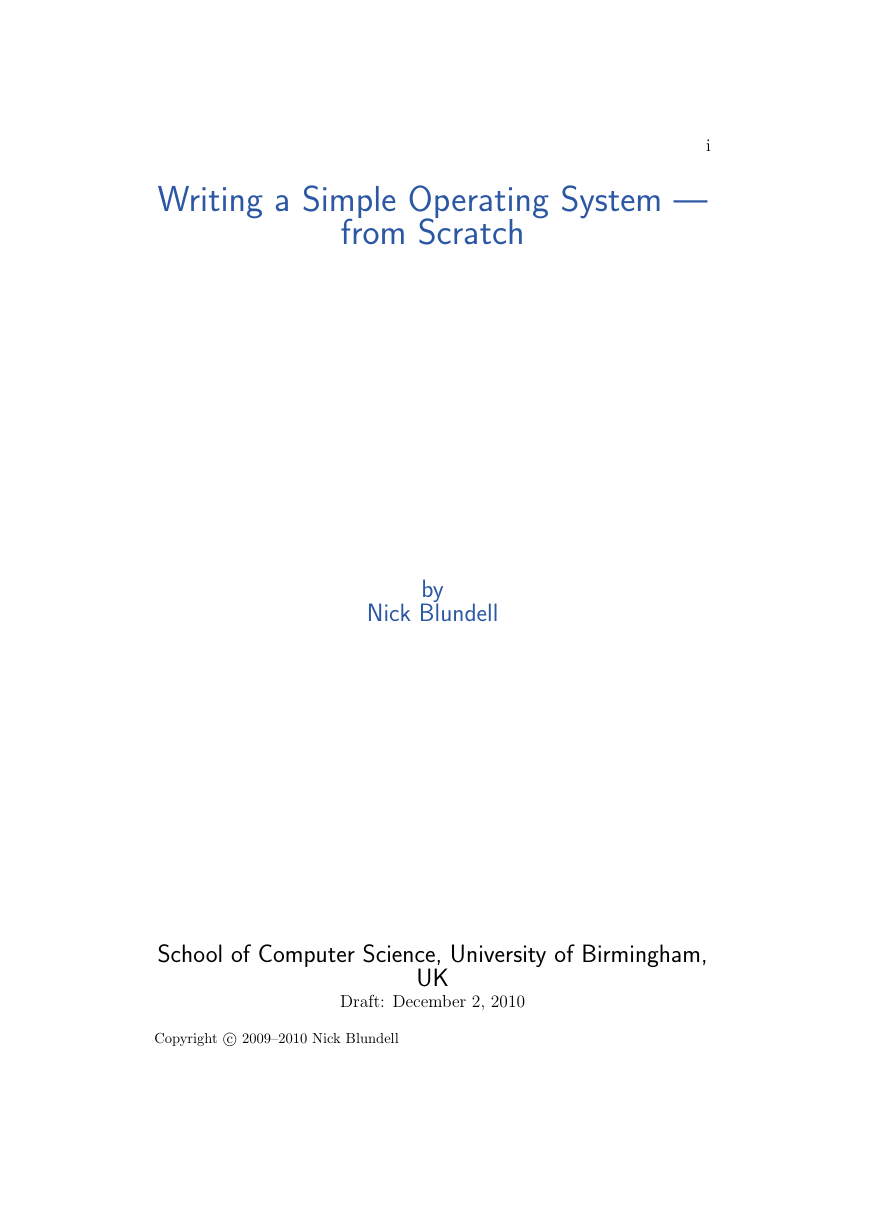
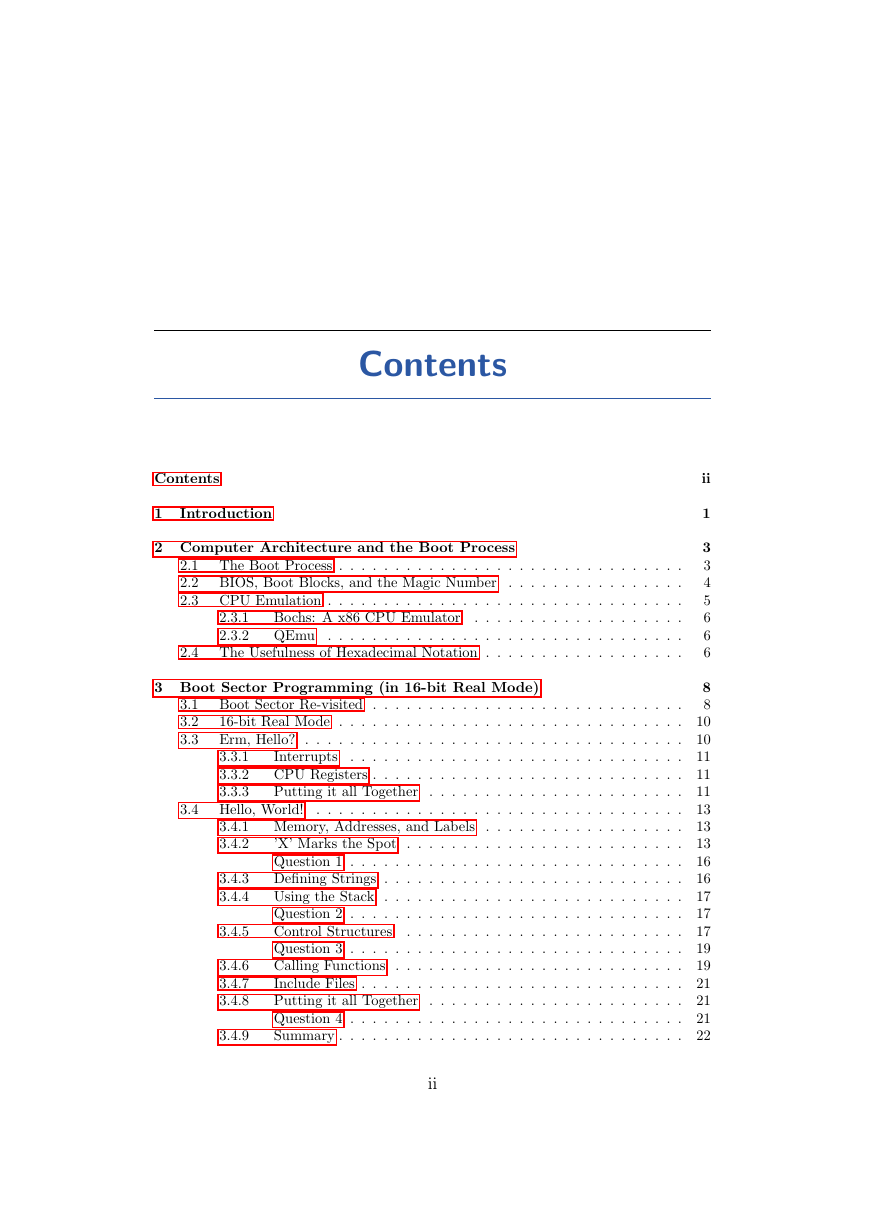
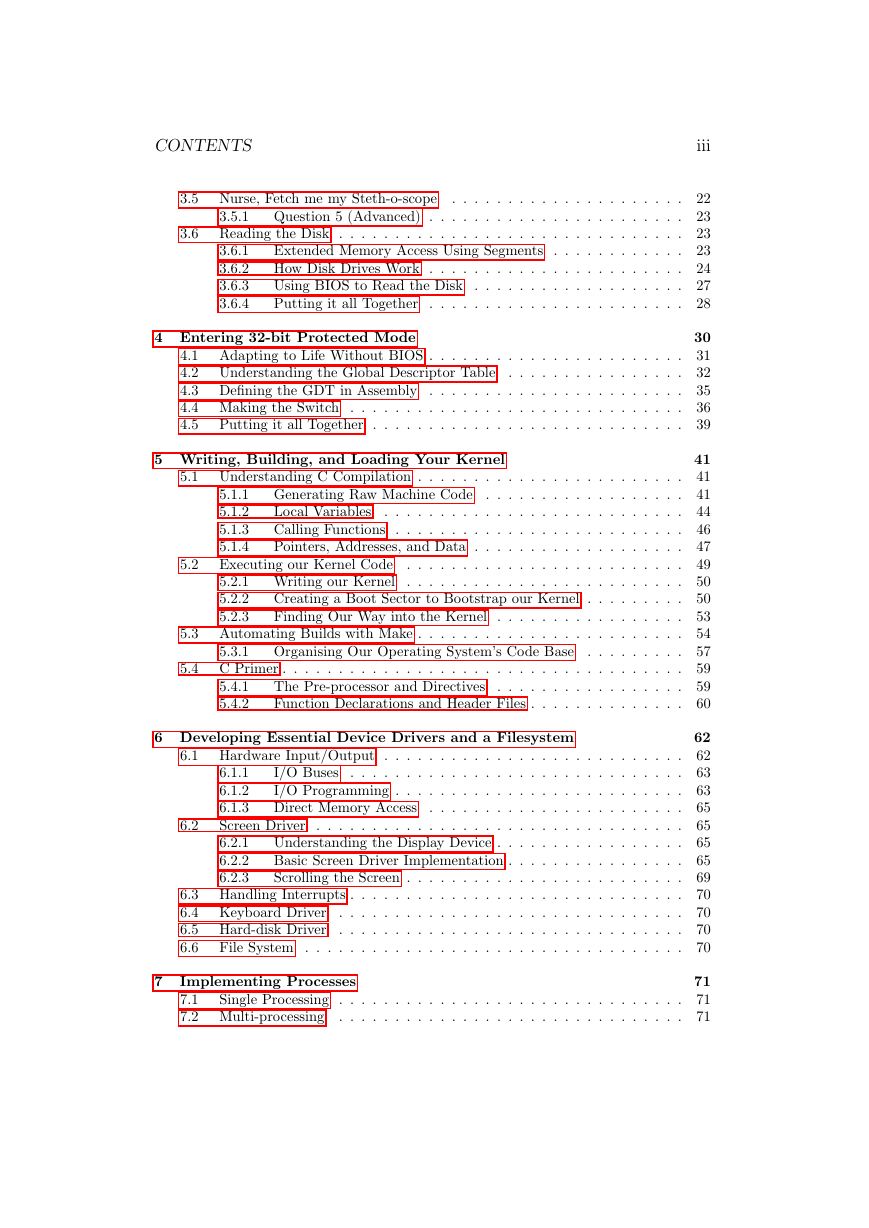
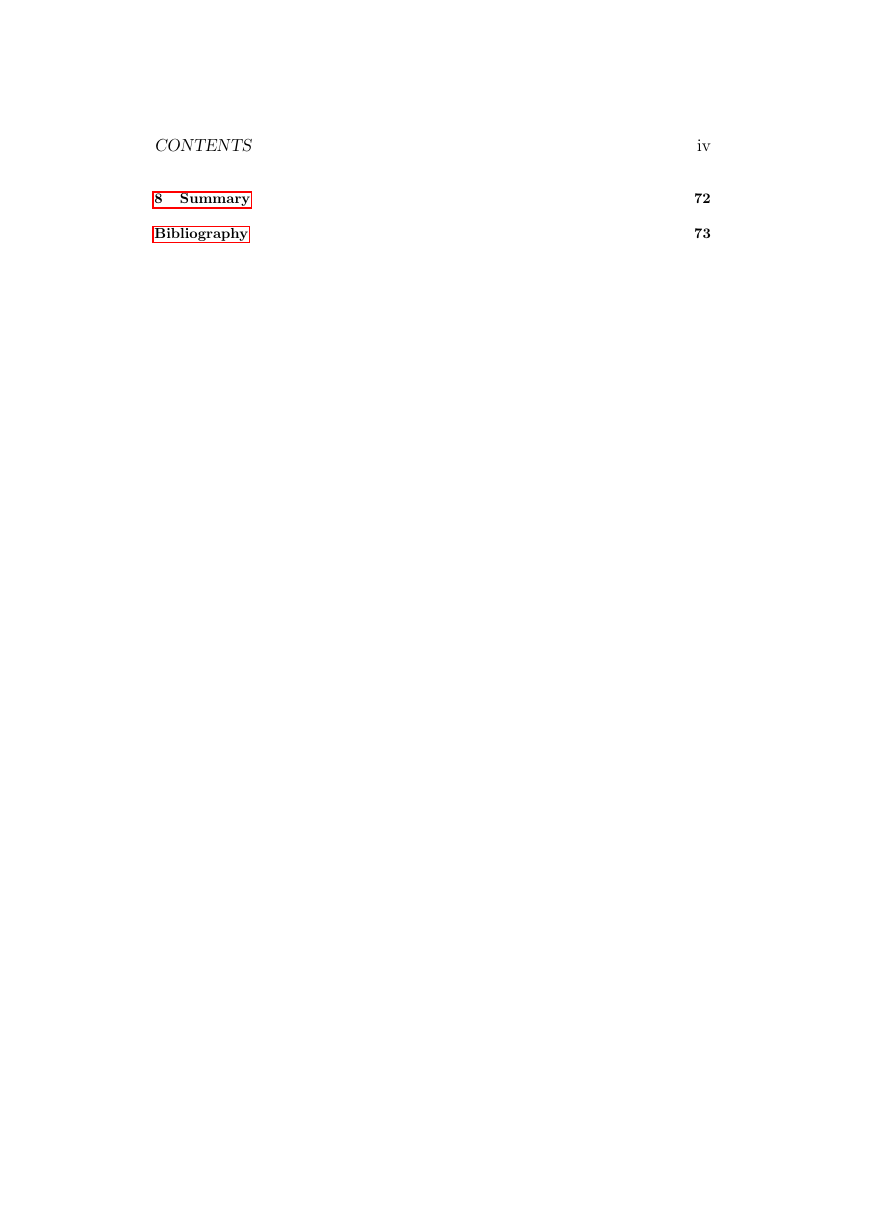
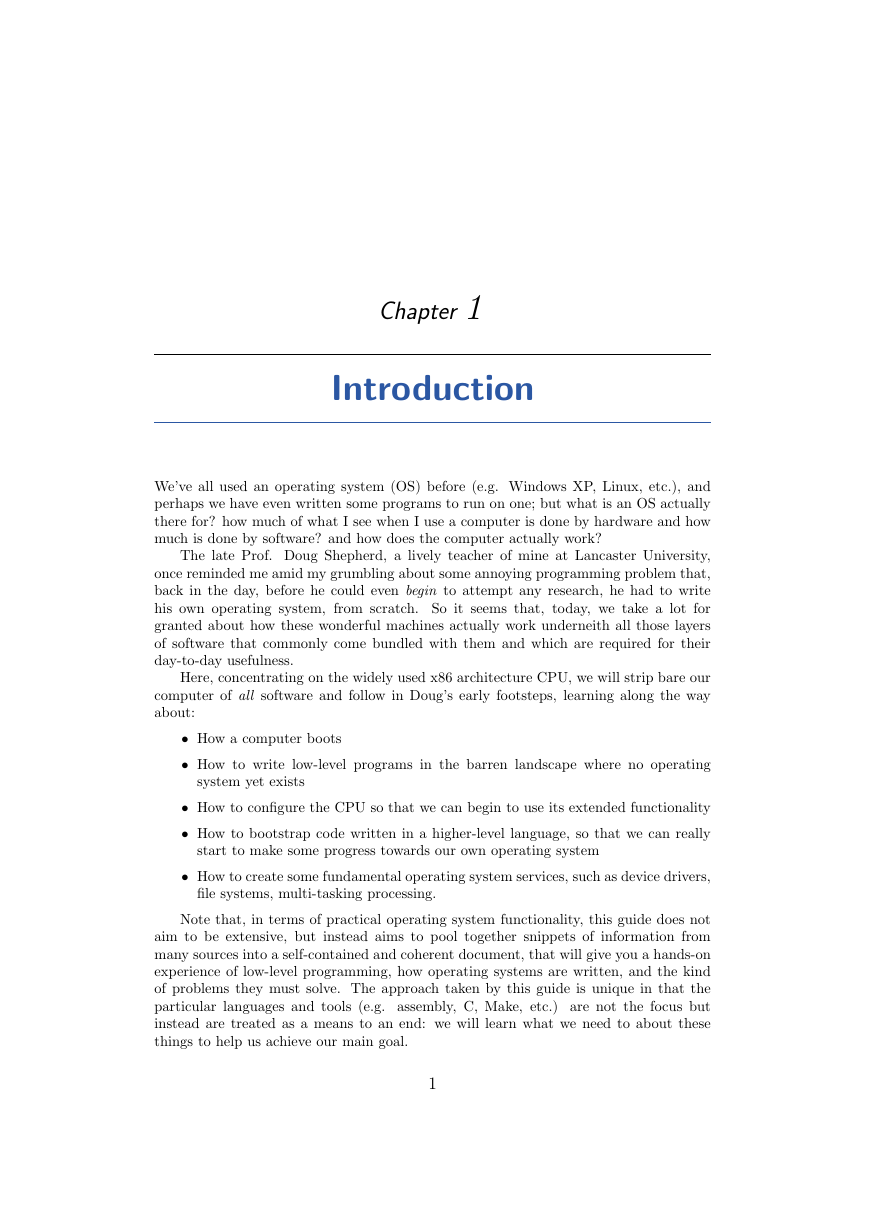
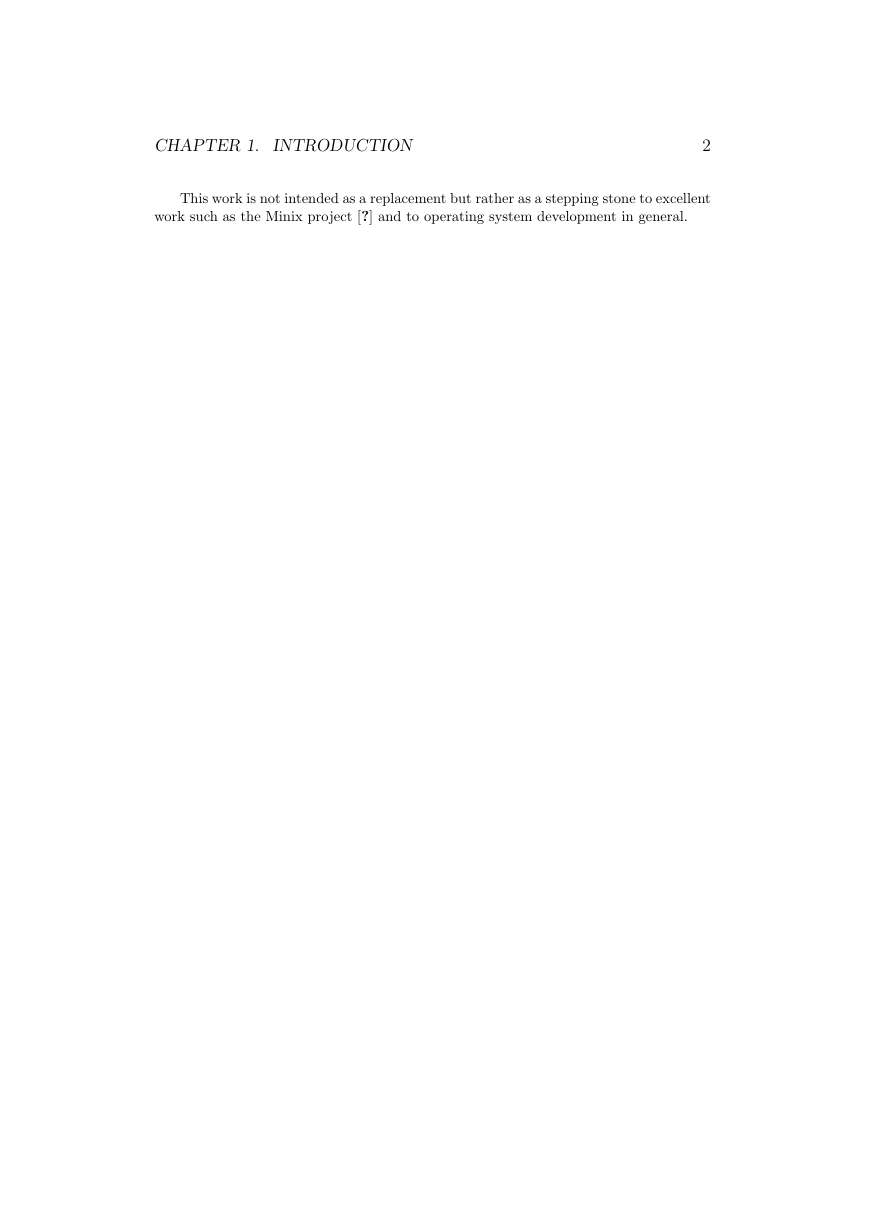
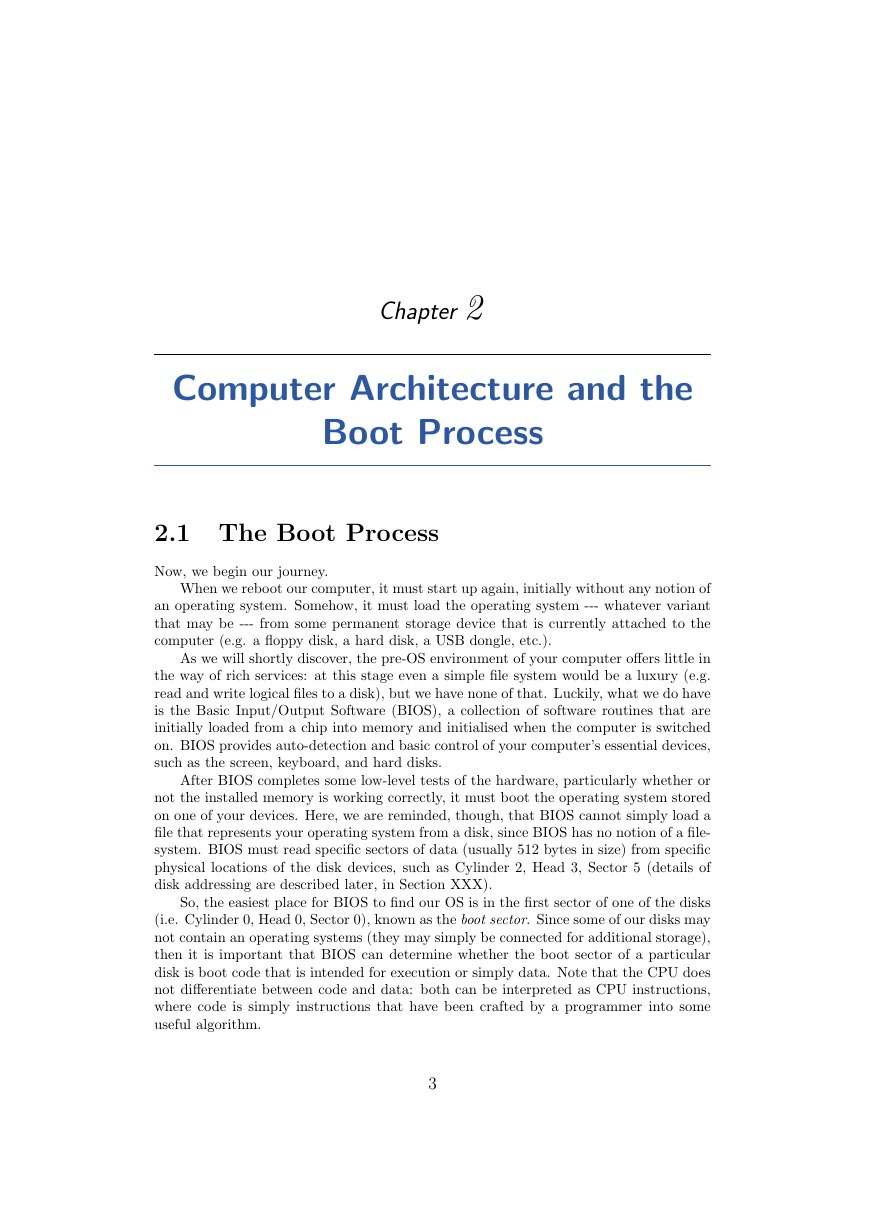
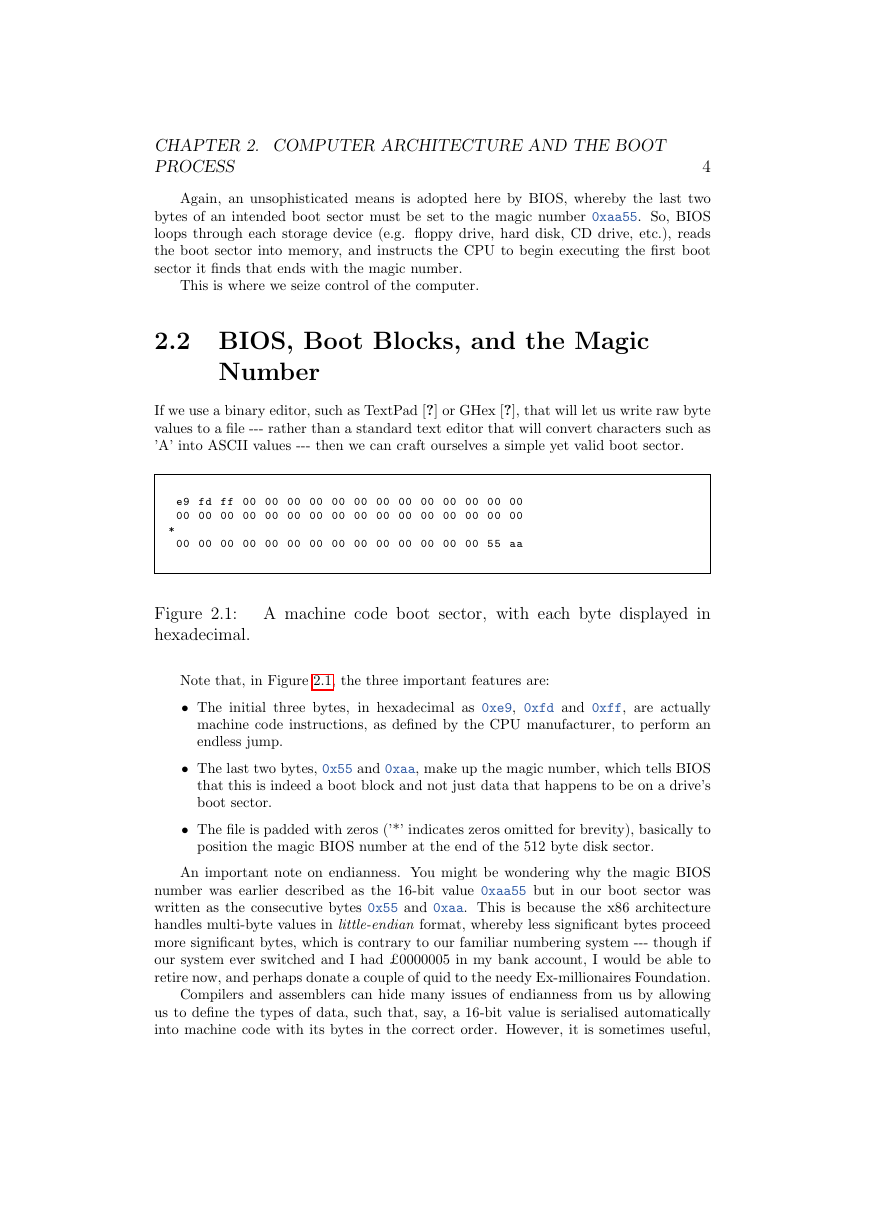








 2023年江西萍乡中考道德与法治真题及答案.doc
2023年江西萍乡中考道德与法治真题及答案.doc 2012年重庆南川中考生物真题及答案.doc
2012年重庆南川中考生物真题及答案.doc 2013年江西师范大学地理学综合及文艺理论基础考研真题.doc
2013年江西师范大学地理学综合及文艺理论基础考研真题.doc 2020年四川甘孜小升初语文真题及答案I卷.doc
2020年四川甘孜小升初语文真题及答案I卷.doc 2020年注册岩土工程师专业基础考试真题及答案.doc
2020年注册岩土工程师专业基础考试真题及答案.doc 2023-2024学年福建省厦门市九年级上学期数学月考试题及答案.doc
2023-2024学年福建省厦门市九年级上学期数学月考试题及答案.doc 2021-2022学年辽宁省沈阳市大东区九年级上学期语文期末试题及答案.doc
2021-2022学年辽宁省沈阳市大东区九年级上学期语文期末试题及答案.doc 2022-2023学年北京东城区初三第一学期物理期末试卷及答案.doc
2022-2023学年北京东城区初三第一学期物理期末试卷及答案.doc 2018上半年江西教师资格初中地理学科知识与教学能力真题及答案.doc
2018上半年江西教师资格初中地理学科知识与教学能力真题及答案.doc 2012年河北国家公务员申论考试真题及答案-省级.doc
2012年河北国家公务员申论考试真题及答案-省级.doc 2020-2021学年江苏省扬州市江都区邵樊片九年级上学期数学第一次质量检测试题及答案.doc
2020-2021学年江苏省扬州市江都区邵樊片九年级上学期数学第一次质量检测试题及答案.doc 2022下半年黑龙江教师资格证中学综合素质真题及答案.doc
2022下半年黑龙江教师资格证中学综合素质真题及答案.doc